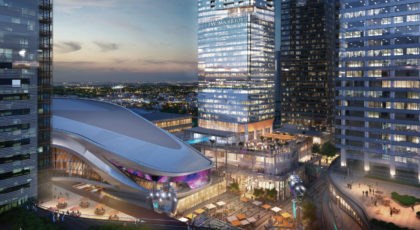Alberta’s hotel industry is experiencing a 52 per cent occupancy rate this year, compared with a 62 per cent average across Western Canada, and revenues are flat, but luxury hotels are underway or opening from the capital city to Canmore.
It’s been 28 years since the Edmonton Oilers won the Stanley Cup, but the owners of the city’s newest luxury hotel think a close proximity to the NHL team will lead to championship-like success.
The JW Marriott hotel is scheduled to welcome its first guests next March as the NHL playoffs get underway.
“The amount of attention the district will get and the arena already gets is nothing but a benefit to us,” said Steve Walton, director of sales and marketing for the JW Marriott in Edmonton’s downtown entertainment district.
The hotel will have 346 guest rooms and 22,000 square feet of meeting space, and the crown jewel will be its main ballroom – named after Oiler hockey legend Wayne Gretzky. At 10,500 square feet, it will be the largest of its kind downtown. The hotel will also have five restaurants and lounges, including a high-end steak house.
It’s the first full-service, four-star hotel in downtown Edmonton in 30 years. The JW has been booking conferences for more than a year and has confirmed major events well into 2019.
“The demand is there, for sure,” Walton said. On top of the hotel’s 22 floors will be another 33 floors of condominiums, making it one of the tallest buildings west of Toronto.
While the JW is the newest hotel in the central business district, it’s certainly not the only one drawing attention. The Hyatt Place opened last year with 210 rooms and just under 10,000 square feet of meeting space.
Karen Chalmers, executive director of Edmonton Destination Marketing Hotels, said hotel space is up about 16 per cent over the last few years.
“During the boom times from 2012 to 2013, it seemed like a great time to build hotels in Alberta,” she said.
Marriott, in fact, has two more luxury hotels underway in Calgary.
Alberta’s average hotel revenue per available room (RevPAR), a key industry metric, will struggle to reach $69 this year, according to CBRE’s Hotel Outlook 2018. This compares with a RevPAR of $83 three years ago.
In Lloydminster, more than 300 hotel rooms were added with the opening of three hotels a few years ago. Almost immediately after the ribbon cuttings, however, the price of oil plunged and Lloydminster hit “rock bottom,” said Katlin Ducherer, the city’s economic development officer.
A similar situation happened in Red Deer, Alberta’s third-largest city. A number of new hotels opened up just prior to the 2014 downturn and there simply hasn’t been enough business to go around ever since.
“Red Deer has been a depressed hotel market for some time,” said Dave Kaiser, president and CEO of the Alberta Hotel & Lodging Association.
For the first six months of 2018, Red Deer hotels have been operating at 46 per cent occupancy with an average room rate of just $109. The national average, by comparison, is 63 per cent occupancy with room rates of $155. In some markets during this past summer, occupancy has been as low as 25 per cent.
“One of our people stayed at a [Red Deer] hotel in August and he was the only guest in the whole place,” Kaiser said.
But a Rocky Mountain hotel developer appears confident in the future.
Clique Hotels president Jim Muir sees Clique’s new Malcolm Hotel in Canmore as a recent pinnacle of his 44 years in the hospitality industry.
“The Malcolm is something very special,” Muir said. The four-star, 127-room luxury hotel will hold its grand opening November 3 as the first luxury hotel built in the resort community in 20 years.
Due to visitor demand for hotel space in the Alberta Rockies, the Malcolm held a soft opening this summer.
The new hotel has already booked two dozen weddings and a dozen large conferences through 2019, Muir said.
A Canmore resident, Muir is confident the Malcolm Hotel will also become a Rocky Mountains landmark and a signal that Alberta’s hotel industry is back.



